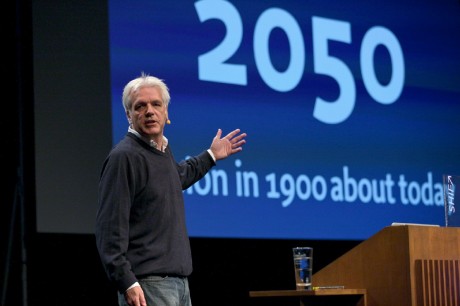To understand why the future Designer is different we first have to take a look at the definition of design. That immediately leaves us with a problem; because how
do we define design? Often design is (by designers) considered an iterated solution to a problem. We define the problem, create a solution, test it’s worth and reiterate where needed to make it fit.
Suppose we say ‘creating solutions for problems’ is the definition of design, where does that leave us? Van Blokland points out that essentially we have two kinds of problems; those you can solve and those you can break-up into smaller problems. The very nature of a problem is the fact that every solution offers another myriad of choices (and therefore problems). That would mean design is never done (but let’s face it; is it really?).
Next, we’re taken through the world of html5/css3, media queries, web fonts and responsive design as Van Blokland illustrates case-studies in which he has essentially semi-automated design. And even though the very fact of ‘automating design’ might offend a whole range of people, we see two examples where he offers his (publishing) client the room to focus on what they are best at: producing high-quality content.
Regardless of the cases; what the audience is presented with is the notion that clinging on to the the known (design should never be automated) is a one-way ticket to getting lost in the crowd.
Van Blokland says; “We had everything on the table, but we couldn’t seem to get the picture” (refering to the future of publishing and the role of a designer and his tools). Tools and methods quickly become outdated and only get us as far as we’re willing to look.
The designer of the year 2050 is an unknown profession and therefore we must dare to look beyond the scope of our current job and set of industry stigma’s.
So, do we have a real answer to what the future designer looks like? To a certain extend we can extrapolate the trades and skills that a good modern designer should have according to current trends and developments. Unfortunately the ever-shifting nature of the design trade doesn’t allow for a direct answer, but at the same time offers a myriad of possibilities.

After VWO/Atheneum-school (pre-university education, grammarschool) Petr van Blokland (1956) studied at the Graphic and Typographic Design Department of the Royal Academy of Visual Arts in The Hague. In 1979 he graduated cum laude (with distiction) and worked as an intern at Total Design in Amsterdam and Studio Dumbar in The Hague. From 1980 until today he was designer and partner in Buro Petr van Blokland + Claudia Mens in Delft. To specialize himself he studied for serveral years at the TU-Delft department Industrial Design. From 1984 until 1989 he taught at the Academy for Visual Arts in Arnhem. Recently he continued his study at the Technical University in Delft on Industrial Design and Artificial Intelligence to apply for a Master Degree. Since 1988 he is a teacher at the Master Type & Media of the KABK in The Hague and AKV St. Joost Graphic Design Bachelor and Master in Breda.
The studio Buro Petr van Blokland + Claudia Mens is specialized in the design of type, solving complex typographic problems and the design of interiors and environments. As part of these projects other aspects of the profession are attended: writing software as design tools and development for digital media belong to the basic toolkit of the studio. The buro is built upon the knowledge and experience of a network of designers, who are capable to exploit these skills in the design proces. Both the design process and the development of the required (digital) tools are highly integrated.
Implicitly Van Blokland reminds us that as modern-day designers we’ll never be doing the same thing for a long time. What might be new today, will be old tomorrow. That leaves this author with only one thought; Don’t you just love your job?
























Pingback: Typo ’11: Tag 2 und 3 und aus | kosmar
Pingback: Typo Berlin Day II and III | Our Blog: Things we like. Stuff we do.